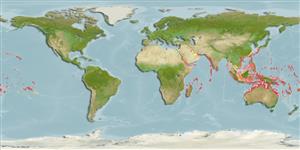>
Eupercaria/misc (Various families in series Eupercaria) >
Labridae (Wrasses) > Corinae
Etymology: Coris: Greek, kore, -es = pupil and also with themenaing of "maid" (Ref. 45335).
More on author: Lacepède.
Environment: milieu / climate zone / profondeur / distribution range
Écologie
marin récifal; profondeur 2 - 30 m (Ref. 1602), usually 2 - 30 m (Ref. 27115). Tropical; 24°C - 28°C (Ref. 27115); 30°N - 30°S
Indo-Pacific: Red Sea and East Africa (Ref. 4392) to the Line and Ducie islands, north to southern Japan, south to Lord Howe and Rapa islands.
Taille / Poids / Âge
Maturité: Lm ? range ? - ? cm
Max length : 120 cm TL mâle / non sexé; (Ref. 5213)
Épines dorsales (Total) : 9; Rayons mous dorsaux (Total) : 12 - 13; Épines anales: 3; Rayons mous anaux: 12. Caudal fin slightly rounded in females, truncate and with filamentous rays in large males; pelvic fins of males very long. Large males also become uniformly dark-green and develop a gibbus forehead and an elongate first dorsal spine (Ref. 1602). Juveniles distinct with the false eyes, shaded by orange (Ref. 48636).
Body shape (shape guide): fusiform / normal; Cross section: compressed.
Occurs in the vicinity of sand or rubble patches of exposed outer reef flats, lagoon reefs, and seaward reefs (Ref. 1602), often in semi-exposed surge zones (Ref. 48636). Adults solitary. Juveniles common in shallow tide pools (Ref. 30573). Feeds mainly on hard-shelled invertebrates including crustaceans, mollusks and sea urchins (Ref. 9823). Minimum depth reported from Ref. 27115. Randall (1999, Ref. 33411) question identity of specimens exceeding 70 cm.
Life cycle and mating behavior
Maturité | Reproduction | Frai | Œufs | Fécondité | Larves
Oviparous, with distinct pairing during breeding (Ref. 205).
Randall, J.E., 1999. Revision of the Indo-Pacific labrid fishes of the genus Coris, with descriptions of five new species. Indo-Pac. Fish. (29):74 p. (Ref. 33411)
Statut dans la liste rouge de l'IUCN (Ref. 130435: Version 2024-2)
Menace pour l'homme
Harmless
Utilisations par l'homme
Pêcheries: intérêt commercial mineur; pêche sportive: oui; Aquarium: Commercial
Outils
Articles particuliers
Télécharger en XML
Sources Internet
Estimates based on models
Preferred temperature (Réf.
123201): 24.6 - 29, mean 27.5 °C (based on 892 cells).
Phylogenetic diversity index (Réf.
82804): PD
50 = 0.5000 [Uniqueness, from 0.5 = low to 2.0 = high].
Bayesian length-weight: a=0.00813 (0.00473 - 0.01397), b=3.12 (2.97 - 3.27), in cm total length, based on LWR estimates for this species & (Sub)family-body (Ref.
93245).
Niveau trophique (Réf.
69278): 3.7 ±0.53 se; based on food items.
Résilience (Réf.
120179): Très faible, temps minimum de doublement de population supérieur à 14 ans (Preliminary K or Fecundity.).
Fishing Vulnerability (Ref.
59153): High to very high vulnerability (72 of 100).
🛈
Nutrients (Ref.
124155): Calcium = 18.2 [7.0, 45.9] mg/100g; Iron = 0.437 [0.249, 0.789] mg/100g; Protein = 18.8 [15.9, 21.0] %; Omega3 = 0.099 [0.049, 0.200] g/100g; Selenium = 40.8 [15.7, 115.1] μg/100g; VitaminA = 62.6 [18.7, 212.5] μg/100g; Zinc = 1.45 [0.69, 2.60] mg/100g (wet weight);
